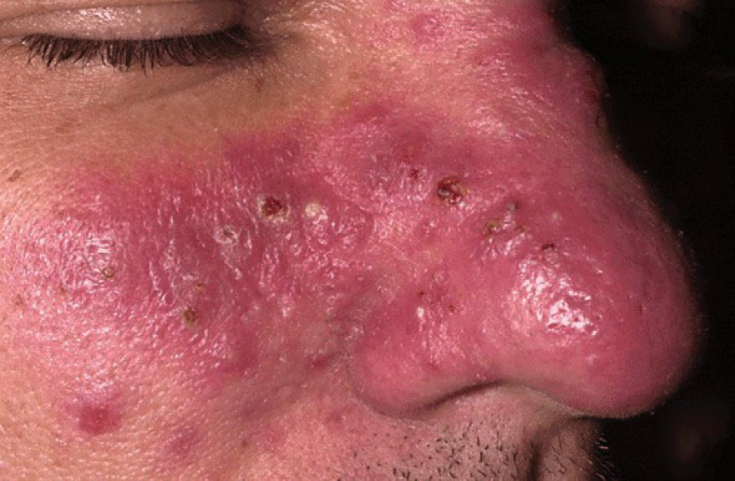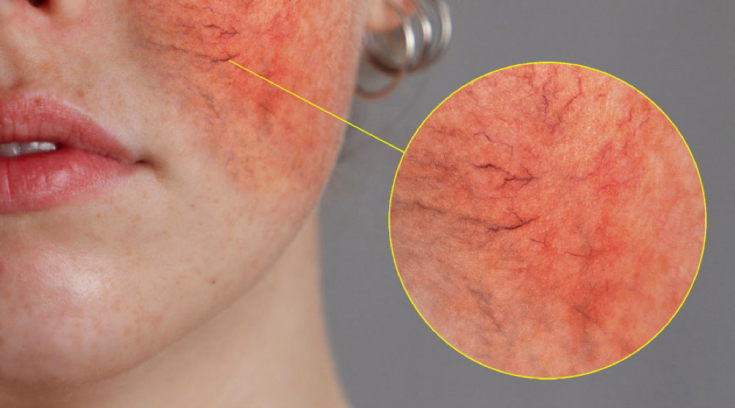Rosacea – a chronic inflammatory skin disease that mainly affects the central part of the face. The disease manifests itself with a number of symptoms that can appear simultaneously or separately and change over time. These include: erythema – persistent redness, which is characterized by periodic exacerbations, is considered a hallmark of rosacea; papules and pustules; telangiectasia; phymatous changes; painful tingling or burning of the skin. Some patients also develop eye symptoms of rosacea. In an article on estet-portal.com, Drs. Sandra Marchese Johnson, Andrew Berg and Chelsea Barr talk about state-of-the-art treatments for rosacea using topical drugs,
- Current approaches to the treatment of rosacea
- Topical treatment of rosacea in the presence of erythema, papules and pustules
- Oral Therapy for Moderate or Severe Rosacea
- Physical therapy for the treatment of telangiectasia and phymatous changes
- The role of proper skin care and
lifestyle in the treatment of rosacea Current approaches to the treatment of rosacea
more than one symptom
such as persistent erythema and pustules.Furthermore, erythema and rosacea lesions are thought to share inflammatory characteristics, including inflammatory cell migration. Persistent erythema may be the first sign of inflammation and therefore requires attention.
According to the consensus recommendations, multiple symptoms of rosaceaare best amenable to combination therapy
with the use of medications, topicalsTopical therapy for rosacea in the presence of erythema, papules and pustules The following agents are FDA approved for topical treatment of rosacea:
Ivermectin cream 1% – with inflammatory formations;
metronidazole cream 0.75% (twice a day) – with inflammatory formations;
- metronilazole gel 1% (daily) – with inflammatory formations;
- azelaic acid 15% gel or foam (twice daily) – with inflammatory formations;
- brimonidine gel 0.33% – with erythema;
- Oxymetazoline Cream 1% – with erythema.
- Topical therapy for rosacea is indicated in most cases. Topical therapy for papules and pustules in rosacea
Ivermectin
According to a meta-analysis of 19 studies, ivermectin is more effective in the treatment of papulopustular lesions in rosacea than other available drugs with comparable safety and tolerability profiles. Topical ivermectin reduces the symptoms of- , including foreign body sensation, burning and photosensitivity.

Azelainic acid reduces the severity of papules and pustules – this has been demonstrated in controlled clinical trials and small single-center post-marketing studies. The most common adverse events after azelaic acid therapy are associated with skin irritation (pain, pruritus, dryness, erythema). Phase III studies have shown that 15% azelaic acid gel reduces the severity of inflammatory elements by 17.5 - 17.8%, and foam with the same concentration of the substance – by 21.2–21.7%.
- Read also:
Topical treatment of erythema in rosacea Redness – typical symptom of rosacea – can be presented in various forms. Depending on the cause of the symptom, approaches to the treatment of erythema may vary.
Redness may be due to:
vasodilation,
anomalies of superficial skin vessels, including telangiectasia; presence of papules or pustules;
- inflammation caused by impaired skin barrier function.
- Alpha-adrenergic receptor agonists
- In August 2013, the FDA approved brimonidine 0.33% gel for the treatment of persistent facial erythema in rosacea, and in 2017 – oxymetazoline cream 1%.
Brimonidine is used in the treatment of erythema in rosacea because the substance causes vasoconstriction and may have anti-inflammatory effects. The drug begins to act quickly, the effect lasts about 12 hours.
You may also be interested in:
Assessing the depth of vascular involvement in rosaceaOxymetazoline also works for about 12 hours, but the effect is slower than with brominidine. Oral therapy for moderate to severe rosacea
Perioral medications may be indicated for moderate to severe rosacea. They are often prescribed for ophthalmic rosacea.While tetracyclines and azithromycin are used for
off-label treatment of rosacea
, only a subantimicrobial dose of doxycycline (40mg). The efficacy of antibiotics in the treatment of rosacea is thought to be more anti-inflammatory than antimicrobial. This explains the effect of subantimicrobial doses of doxycycline – the drug has an anti-inflammatory effect in concentrations that are not sufficient to suppress bacterial activity.
Due to changing patterns of resistance, experts are moving away from using standard doses of antibiotics to treat rosacea.
If standard doses of antibiotics are prescribed for rosacea, the course should be limited and patients should be switched to topical therapy
Physical therapies may be indicated for the treatment of telangiectasias and phymatous changes in rosacea.
Lasers and IPL-therapy demonstrate efficacy in the management of these symptoms of rosacea, however data are limited to a small sample.
Informing Patients
– an important condition for effective control of chronic inflammatory skin disease. The patient should be made aware that lifestyle changes can significantlyreduce the symptoms of rosacea.
Proper skin care for rosacea aims at:
recovery of the skin barrier; UV protection.
The application of topical preparations to skin with impaired barrier function increases the risk of treatment intolerance.
Proper skin care – the most effective way to relieve dry skin and the discomfort of rosacea.
- For rosacea, it is recommended to regularly use sunscreens with SPF 30 or higher, which provide broad spectrum protection against:
- UVA;
infrared radiation;
blue light.
- It is also recommended to use light moisturizers and cleansers.
- Read also: The role of home care in preventing the onset and exacerbation of couperosis in rosacea
A wide range of treatment methods allows the doctor to create an individual treatment plan for rosacea for each patient and get excellent clinical results. Topical preparations form the
mainstay of rosaceatherapy and can be very effective in controlling acne and erythema, as well as itching, stinging and burning of the skin. Trigger avoidance and proper skin care greatly enhance the effectiveness of rosacea therapy. Adapted from J Clin Aesthet Dermatol
More interesting videos on our YouTube
-channel!







Add a comment